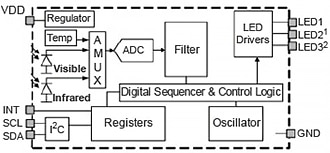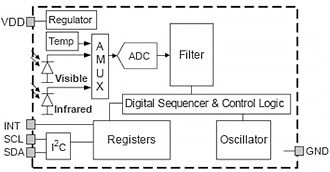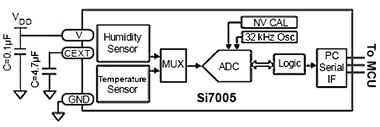 Sensors Series - Part 2 - IoT Wearable Devices
Sensors Series - Part 2 - IoT Wearable Devices
Perhaps ever since the introduction of the *** Tracy Two-Way Wrist Radio many decades ago, the fascination with and utility of wearable devices has steadily increased (1). But today's wearables are a far cry from the creative inventions of Hollywood copywriters from an age gone by IoT wearable devices today are powerful tools that can sense, process, store, and communicate significant information. The great leap forward in wearable devices is not only the result of its innovative technology, but also the applications they now can provide such as patient monitoring, wellness/sports/fitness, entertainment, and other forms of computing. But all wearable devices today have one thing in common: they all use sensors. And there are all kinds of IoT wearable device sensors available today, including temperature, UV, proximity, heart rate, motion and many others. This learning module is an introduction to some of the common types of sensors used in IoT wearable devices today.
Related Components | Test Your Knowledge 
sponsored by
(1) Of course, this statement is the subjective inclination of the author of this learning module. Perhaps the reader may find his/her fascination with wearable devices from The Jetsons' Promotional Wrist Watch or the Star Trek Communicator or some other très chic device. If you are so inclined to evangelize about your preferred technological inspiration, please leave your comments below.
2. Objectives
The objective of this learning module is to provide you with basic knowledge of sensors used in IoT wearable devices. You will first review some of the main concepts of sensor technology and then get an overview of the approaches to human body sensing. In the last section, you will learn about the main types and characteristics of sensors for wearable IoT devices.
Upon completion of this learning module, you will be able to:
- Review sensor essentials covered in Sensors I
- Discuss how the human body is sensed
- Describe how photoplethysmographic technology is used in IoT wearable devices
- List the main types of types of sensors for wearable IoT devices
- Explain the features of the most common wearable device sensors
3. Review
In the first Essentials Sensors learning module, the definition of a sensor was presented, as well as the classifications and characteristics of IC sensors. Let's revisit some of the important terms from Sensors I that are applicable to this learning module:
- Definition: According to The Handbook of Modern Sensors: Physics, Designs and Applications, a sensor is defined as "a device that receives a stimulus and responds with an electrical signal."
- Categories: There are two main categories of sensors: simple and complex. Simplex sensors typically have a sensing function only, while complex sensors can have both transduction and sensing functions due to the integration of signal conditioning, A-to-D conversion and other circuitry within the sensor's integrated circuit package.
- Classifications: Sensors can be classified in a variety of ways. Passive/Active, Absolute/Relative and Digital/Analog are the most common classifications. There are also other ways to classify sensors, but, for the most part, these are for special situations. These special situations include: characteristics, material, applications, and type of stimulus.
- Characteristics: Sensor characteristics describe the capabilities and parameters of specific sensors. The common characteristics include: Accuracy, Dead band, Drift, Hysteresis, Linearity, Nonlinearity, Offset, Precision, Range, Repeatability, Resolution, Response Time, Saturation, Sensitivity, and Stability. Sensor characteristics are normally found in a datasheet, user guide or other documentation. These documents provide specific information that's essential to understanding not only how to select a sensor, but also on how to use it in a specific application.
4. Approaches to Human Body Sensing
While there are many types of physical conditions that IoT devices are capable of sensing – acoustic, electric, magnetic, mechanical, optical and thermal – wearable devices primarily sense biological (or biochemical) conditions and the body's movement. Gaining an understanding of these conditions with respect to human body sensing is a necessary prerequisite to understand the applications of sensors in IoT wearable devices.
To begin, the physical condition of the human body can be sensed in three different ways: the skin, body fluids and movement. Let's discover in this section of the learning module how these components can be used in a wearable device sensing design.
- 4.1 The Skin
While we may discount the importance of the human skin (excluding perhaps a nice tan at your favorite beach in the summer) or even forget that the skin itself is a body organ, the fact is that the skin is a superb “natural” sensor. It senses both internal and external conditions. And it responds to heat, cold, fear, pressure, pleasure and pain. As a medium for determining the overall condition of the human body, the skin can be leveraged to gather data on body temperature, blood pressure, heart rate, peripheral capillary oxygen saturation (SpO2) and more.
- 4.2 Body Fluids
Body fluids also tell us a lot about the condition of the human body. Blood has long been used as a medium for sensing the body's medical condition; however, it requires an invasive sensing technique that is not always desirable to use. Therefore, a lot of new and non-invasive techniques are being developed utilizing sweat, tears, saliva and interstitial fluids. In general, body fluids can be used by wearable device sensors because they contain a lot of chemical and biochemical information about the state of the body's functions. What follows is an overview of the information body fluids can provide:
- Sweat contains a lot of biological substances such as sodium, chloride, potassium, calcium, ammonia, glucose, and lactate. For fitness activities, sweat can tell a lot about the body's hydration level and electrolyte balance. Since it is readily accessible by a wearable device, it is the easiest fluid to leverage as a source of information about the condition of the body.
- Saliva contains an incredible amount of biological information. It includes ions of sodium, potassium, chloride bicarbonate, nitrates, urea, uric acid, creatinine, and hundreds of types of proteins. The downside of saliva as a sensing stimulus is that it also possesses, in varying degrees, mucus, food debris and blood, all of which can impede the operation of a sensor.
- Tears are another body fluid that can be used by a wearable device to sense the condition of the body. They contain proteins, electrolytes and sugars like glucose that can be leveraged in diabetes monitoring.
- Interstitial fluids – fluids that surround tissue cells – contain sugars, salts, fatty acids, amino acids, coenzymes, hormones, and more. These fluids tell a lot about the condition of the body and would be typically used in wearable medical devices such as diabetes monitors.
- 4.3 Body Movement
The movement of the body can be utilized in monitoring the motor activities of a human being. The human body's motor activities are useful in patient monitoring, especially for movement disorders such as Parkinson's Disease or diseases related to Parkinson's such as bradykinesia. Motion sensors such as accelerometers, gyroscopes or magnetometers can be placed in wearable devices or in garments to obtain movement data.
5. Introduction to Photoplethysmographic Technology
For many years, heart rate monitoring has been recognized as a useful parameter in both diagnosing diseases (e.g., autonomous neuropathy, cardiac arrhythmia or infarction, etc.) as well as in optimizing the physical regimen of an athlete. In general, heart rate monitoring has been accomplished using a variety of technologies, with the most common ones, being:
- Bio-potential (electrocardiography - EKG)
- Electric acoustic (phonocardiography)
- Ultrasonic (echocardiography)
- Bio-electrical (impedance cardiography)
Despite the above time-tested technologies, photoplethysmographic technology (PPG) has found new interest by researchers and designers in the area of heart rate monitoring because of it offers a compact, low cost, simple and low power technology that's a good fit for the growing wearable market of fitness and medical devices.
In its most basic form, PPG technology utilizes an LED and photo-detector as well as associated circuitry to make up a pulse oximeter, which offers a way to determine the heart rate by assessing the arterial pulsability of tiny networks of blood vessels in the tissue of the skin. As an optical sensor, PPG illuminates living tissues with a light source, gathers a portion of the light that propagates through the tissue, and then analyzes the resulting attenuated light. LEDs are typically used as the light source and detector for PPG-based heart rate monitors.
One of the challenges of using PPG technology in this application is that in some areas of the body (e.g., forehead, ankle, and torso) the emitted light is fully absorbed by the body. In these cases, the PPG optical sensor can be operated in an alternative “reflectance” mode where the light source is placed next to the detector to collect the propagated light by means of the light scattering effect. The reflectance mode allows the PPG-based heart rate monitor to be used on many different parts of the body such as the wrist, forearm and ankle – all ideal for use in wearable devices such as smart watches, and fitness or arm bands.
6. Types of Sensors
Since the field of wearable IoT devices is expanding so rapidly, it would be difficult to cover every type of sensor that IoT wearable devices would utilize. Electronic textiles, micro needle arrays, wearable colorimetric sensors, body-conformable electronics, one-time/re-usable sensors, invasive/non-invasive sensors, and implantable devices are all part of this exciting yet burgeoning field of technology. Since this is an essentials learning module, we will only focus on the most common types of wearable sensors that feature the following characteristics: low-power, lightweight, compact form factor, and multi-functional.

Silicon Labs Si114x Multi-LED Heart Rate, SpO2, Proximity and Ambient LightWearable devices, such as smart watches or activity-tracking wrist and arm bands, typically have more stringent requirements than handheld or other portable devices. They are smaller and must be comfortable to wear, and they need to be lightweight and low-power. To meet these requirements, manufacturers will produce multi-functional, highly integrated sensors. To illustrate this sensor design approach, the Silicon Labs' Si114x Series sensors combine digital UV index sensing with ambient light and blood oximetry sensing on a single chip. This sensor is designed to track UV sun exposure, heart rate, blood oximetry and proximity/gesture control. 
Packaged on a tiny 2 mm x 2 mm clear QFN package, the monolithic Si114x sensors integrate multiple photodiodes, an analog-to-digital converter, a signal processor, up to 3-LED drivers and a digital I2C control interface. This low-power sensing family enables long battery life with standby less than 500 nA and an average power of as little as 1.2 uA with once per second real-time UV Index measurements. Capable of controlling one, two and three-LED systems, the sensors enable developers to implement proximity detection with a range over 50 cm, multi-dimensional systems capable of advanced 2D/3D motion sensing, heart rate/pulse oximetry measurements, or cheek detection. The Si114x sensors' LED drivers enable implementation of reflective heart rate and blood oximetry measurement capabilities for health and fitness trackers, as well as touchless interfaces that support end-user control from a distance. Different models in the Si114x family offer advanced motion and gesture sensing. |

Si1132 Ultraviolet (UV) Index and Ambient Light SensorUV sensing in wearable devices has seen an increase in demand in recent years. UV tracking is helpful for those with an elevated risk for sunburn or for people who have concerns about excessive sun exposure. But conventional UV sensors require UV-sensitive photodiodes along with an external microcontroller (MCU), analog-to-digital converter (ADC) and signal processing firmware. Lacking a high level of integration gives them a larger footprint and places some limits on their use in compact wearable IoT devices. 
A good example of how the problem of conventional UV sensors is solved is with the Si1132 UV index and ambient light sensor IC. It's a monolithic sensor that integrates multiple photodiodes, an analog-to-digital converter, a signal processor and a digital I2C control interface in a small 2 mm x 2 mm clear QFN package. (Note: Standardized by the World Health Organization (WHO), the digital UV index is linearly related to the intensity of sunlight and is weighted according to the Erythemal Action Spectrum developed by the International Commission on Illumination (CIE). This weighting provides a standardized measure of our skin's response to different sunlight wavelengths including UVB and UVA.) |

Silicon Labs Si705x Digital Temperature Sensor ICTemperature sensing is the most commonly measured parameter for monitoring the condition of a human body. Low body temperature can be an indication of hypothermia, but it can also be a symptom of infection, kidney/liver failures, shock, stress and others. On the other hand, high body temperatures can indicate a fever (hyperthermia) accompanying the flu, or can indicate the more harmful heat stroke. 
The Silicon Labs' ultra-low-power, high-precision Si705x digital temperature sensor offers accurate temperature sensing in a lightweight and compact form factor that's ideal for wearable and other portable devices. It consumes only 195 nA when sampled once per second, which minimizes self-heating and enables multi-year coin cell battery operation. Traditional approaches to temperature sensing, using thermistors or embedded MCU temperature sensors, often lack accuracy and possess higher power consumption. Although improved accuracy can be achieved through end-of-line calibration, this technique presents additional manufacturing costs; the sensor's accuracy can still be susceptible to variations in power supply voltage. In contrast, the Si705x sensors' signal processing technology provides stable temperature accuracy over the entire operating voltage and temperature ranges without the need for costly end-of-line production calibration. The Si705x Series sensor maintains its accuracy across the full operating temperature and voltage ranges and has four different accuracy levels up to +/-0.3 °C. Available in a compact 3 mm x 3 mm DFN package, the Si705x Series sensors feature an industry-standard I2C interface for easy configuration. With a low 1.9 V minimum power supply voltage, it can be connected directly to a battery without the need for an external voltage regulator. It also provides up to 14-bit temperature resolution for high-precision measurement. |

Si7005 Relative Humidity and Temperature SensorsTypical approaches to relative humidity (RH) sensing use discrete resistive and capacitive sensors, hybrids and multi-chip modules (MCMs). These approaches suffer from high bill of materials (BOM) costs, high component counts, large footprints, and the need for labor-intensive calibrations. Silicon Labs solves the problems of conventional RH sensors with its Si7005 digital relative humidity and temperature sensor. It uses low-K polymeric dielectrics for sensing humidity, which enables the construction of a low-power, monolithic CMOS sensor IC with low drift and hysteresis, and excellent long term stability. 
Temperature is sensed by a precision band gap referenced circuit on the die. Humidity is sensed by measuring the capacitance change of low-k dielectric layer applied to the surface of the die. Both temperature and humidity are precisely measured in very close proximity on the same monolithic device, providing exceptional measurement accuracy. The Si7005 device consumes only 2 µA on average at one measurement per minute. It integrates sensing elements, an analog-to-digital converter (ADC), signal processing, non-volatile memory for calibration data and an I2C interface in a monolithic CMOS IC. This high level of single-chip integration makes the sensor rugged and reliable, reduces cost and development time, and simplifies board design. |

Silicon Labs CPT112S-A01-GM Capacitive Touch Sensor ControllerIt is easy to add capacitive touch to wearable or other portable devices with the Silicon Labs' CPT112S TouchXpress Capacitive Touch Sensor Controller. It supports up to 12 capacitive sensor inputs in a 3 mm x 3 mm QFN package. The I2C interface provides an easy way to track the status of touch sensors, and an interrupt pin can wake the host processor from sleep after a proximity touch detection. The device also comes with advanced features like moisture immunity, wake-on proximity, and buzzer feedback for an enhanced user experience. No firmware development is needed, and all the capacitive touch sense parameters can be configured using a simple GUI-based configurator.  |
7. Sensor Evaluation Boards
Sensor evaluation boards make it easy to learn, test, and develop sensor applications. Here are some of the currently available sensor evaluation boards for the sensors described in this learning module:

Environmental and Biometric Sensor Puck with Bluetooth Low Energy and iOS/Android AppThe SENSOR-PUCK is a demo platform for the Silicon Labs' Si114x Series Optical Sensors and Si701x/2x Series Relative Humidity and Temperature Sensors. Powered by a coin-cell battery, it is controlled by an EFM32 |

Silicon Labs SLEXP8008A Capacitive Touch Sense EVMThe SLEXP8008A is an evaluation board for the CPT112S TouchXpress Capacitive Sensor Controller. The board serves as a user input peripheral for application development. It can be configured for different touch sense capabilities and also contains breakout pads and other peripherals for user feedback. It has 8-Capacitive Sense touch pads a 4-Channel Capacitive Sense slider. A Buzzer and a 20-pin expansion header is available for connection to a Silicon Labs Starter Kit (EFM8 or EFM32). |

Sensor Expansion Evaluation Board Sensor-EXP-EVBThe SENSOR-EXP-EVB is a development board for Silicon Labs' Si701x/2x Series Relative Humidity and Temperature Sensors and Si114x UV Index, Ambient Light, Proximity and 3D Gesture Sensors. The card plugs into the expansion header of the EFM32 |

Biometric Sensor Expansion Card for EFM32
|
*Trademark. Silicon Labs is a trademark of Silicon Laboratories, Inc. Other logos, product and/or company names may be trademarks of their respective owners.
is a trademark of Silicon Laboratories, Inc. Other logos, product and/or company names may be trademarks of their respective owners.
Test Your Knowledge
Sensor Skills 2

Are you ready to demonstrate your knowledge of sensors for IoT wearable devices? Then take a quick 15-question multiple choice quiz to see how much you've learned from this Essentials Sensors 2 module.
To earn the Sensors 2 badge, read through the module to learn all about sensors for IoT wearable devices, attain 100% in the quiz, and leave us some feedback in the comments section.

